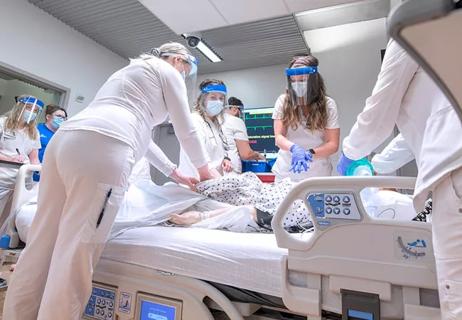By Deborah Small, DNP, RN, NE-BC
Cleveland Clinic is a non-profit academic medical center. Advertising on our site helps support our mission. We do not endorse non-Cleveland Clinic products or services. Policy
Across the healthcare industry nurse leaders are implementing strategies and care models that are centered on two things: the patient and the patient’s family.
Implementing patient- and family-centered care (PFCC) strategies requires a true transformation of care – and there are bound to be a few obstacles and challenges along the way. However, there are various ways leaders can work to overcome these barriers and emerge with a successful PFCC model.
Healthcare systems like Cleveland Clinic are a complex combination of medical hospitals, institutes and services, which can create significant barriers to standardizing care quality. Three of the most common, include:
Existing system-wide technologies and policies are not uniform.
Non-uniform technologies and policies can undoubtedly slow down any chance of successful and timely implementation of PFCC. The fastest way to deliver consistent PFCC is to create uniformity and standardization of technologies and policies as quickly as possible.
The model of care does not work for all medical specialties.
Traditionally, patient care models were created for one role – the bedside nurse in the hospital setting. However, nurses today have multiple roles and, thus, PFCC care models should reflect these roles. PFCC models need to offer guidance that will help nurses perform in a variety of roles – from direct caregiver to central coordinator of care to supporting team member and so on.
Nursing caregivers are not engaged or accepting of PFCC policies.
While standardized models, policies and procedures that depict how nurses should apply their knowledge and skills are vital to successful implementation of PFCC, equally as imperative is nurse buy-in and engagement. Managers must motivate nurses to vigorously apply PFCC standards and policies, ensuring nursing caregivers are on-board. Organizations like Gallup and Press Ganey agree that nursing engagement is directly linked to better patient outcomes.
When Cleveland Clinic created and implemented its PFCC model roughly one decade ago, leaders from the Stanley Shalom Zielony Institute for Nursing Excellence began by appointing a steering committee of key stakeholders (representing each hospital and service) to conduct a thorough assessment of the current state of nursing throughout the health system.
The assessment primarily consisted of 10 focus groups with nurse managers, assistant nurse managers, advanced practice nurses, charge nurses, registered nurses, licensed practical nurses, nurse aides and clinical instructors throughout the health system. Content highlighted topics such as nurse feedback on a new care model, daily job tasks and barriers to care. The committee also garnered feedback from other hospitals and health systems as well as Cleveland Clinic physicians.
Results were used to develop “guiding principles” for Cleveland Clinic’s new PFCC model that supported the vision, core values and guiding principles of Cleveland Clinic and the Zielony Nursing Institute.
From there, the current nursing care delivery process was mapped out, including accepted definitions, expected competencies, practice environments and levels of care. Specific issues to address in the new model were also identified.
When the analysis was complete, the team reviewed nursing and management literature to determine the best theoretical framework for Cleveland Clinic’s new PFCC nursing practice model. It was determined that existing nursing care models – even patient-centered ones – were too specific and task-oriented to adequately encompass the issues facing a complex health system.
In addition to the patient and the patient’s family, Cleveland Clinic’s nurse leaders wanted the new practice model to reflect the concerns and needs of the Cleveland Clinic nurse and the Cleveland Clinic nursing institute. As a result, Cleveland Clinic combined nursing care theories with broader-based management theories to achieve complete coverage of identified issues.
The new model was centered on Cleveland Clinic’s “Patients First” guiding principle and was designed to help nurses deliver consistent care and respond to an infinite variety of patient and family needs.
To establish a unifying approach to care, Cleveland Clinic’s new PFCC nursing care model included a foundation of system thinking based on Shared Vision (Based on work by P.M. Senge). This allowed the following three concepts of care to be combined into a Framework of Care:
The Framework of Care formed the foundation for nursing practice and encompassed four different domains. The domains, which allowed customization for a nurse’s specific role, professional goals, and personal preferences, are:
To help nurses understand how to use the new practice model, a visual image of the new care delivery process was developed, entitled “Colleagues in Care Delivery.” It symbolized the shared vision of “Patients First” by visually focusing on the nurse working together with the care delivery team for the benefit of the patient. Additionally, a standard care pathway tool was developed to help nurses and nurse managers implement the new model. The tool included seven major steps in care, along with specific reminders of critical policies that could be customized to the unique needs of the unit or patient-care setting.
Cleveland Clinic’s PFCC model was initially launched to approximately 500 nurse managers at the Zielony Institute’s annual nursing leadership retreat in 2010. It was then rolled out to the health system’s nursing caregivers through a proprietary toolkit, online educational modules and chief nursing officer presentations. The rollout was supported by videos of nurses using model concepts and consisted of mandatory training sessions, as well as the assignment of champions to aid with model execution.
Throughout the years, the PFCC model has undeniably become a key part of the Zielony Nursing Institute culture. Not only is it part of the daily life of a Cleveland Clinic nurse, since the model’s introduction, there have been several significant and noticeable improvements in both nurse and patient experiences at Cleveland Clinic.
Without question, today’s Cleveland Clinic nurses are more engaged than they were pre-PFCC model. With every employee engagement survey taken since 2009, nurse engagement has consistently improved. In Cleveland Clinic’s most recent employee engagement surveys, which are distributed by Press Ganey, overall nurse engagement climbed from 4.14 in 2015 to 4.22 in 2017.
Additionally, nurse communication at Cleveland Clinic has grown leaps and bounds since PFCC model implementation. Ensuring excellent nurse communication is one of the most important indicators in the Centers for Medicare & Medicaid Services’ (CMS) Hospital Consumer Assessment of Healthcare Providers and Systems (HCAHPS) survey. In fact, it is often identified as having the single greatest effect on how highly patients rate their overall hospital experience.
In 2009, before implementing the PFCC model, Cleveland Clinic’s enterprise-wide score for the nurse communication component of the HCAHPS survey was below the 20th percentile. One year after model implementation, scores climbed to the 35th percentile. By 2014, nurse communication ranked just shy of the 70th percentile and it has sustained this ranking for the past three years, consistently producing scores between the 60th and 70th percentiles.
Deborah Small is Vice President of Patient Care Services and Chief Nursing Officer of Cleveland Clinic Fairview Hospital.
Be a part of the largest independent patient experience event in the world. Join us for the Patient Experience: Empathy + Innovation Summit May 18-20, 2020, in Cleveland, Ohio.

Leadership rounds educate nurses and foster teamwork

Veteran nurse shares his experience as a caregiver and community volunteer

Decision tree amplifies commitment

Hospital earns nine exemplars from the Magnet Recognition Program®

Supporting newly graduated RNs before and after the pandemic

PULSES sets forth six critical steps

Creating a roadmap to get everyone on board

SHINE program is seeing results